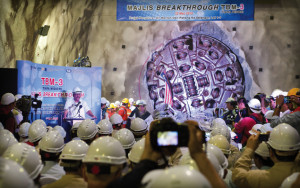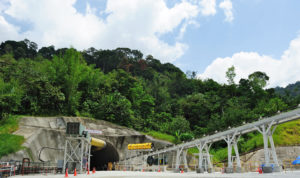![65 Years of Innovation and Experience [default]](https://www.robbinstbm.com/wp-content/uploads/2017/04/Side-Bar-Blue-Blocks_70-Years.jpg)
A Solution for Every Condition: Search our Project Database
Project Map
FEATURED PRODUCT: CROSSOVER MACHINES
Our History
A Legacy of Innovation
Information 24/7
News & Media
Insights in the Industry:
Read the Robbins Blog
 The Pahang Selangor Raw Water Tunnel, for the Malaysian Ministry of Energy, Green Technology, and Water, conveys raw water from the Semantan River in Pahang to the South Klang Valley area of Selangor state. The three tunnels, totaling 44.6 km (27.7 mi), address projected water shortages due to the area’s rapidly growing population. The tunnel transfers 27.6 cubic meters (7,300 gallons) of water per second to a new treatment plant. The drinking water supplies about 7.2 million people.
The Pahang Selangor Raw Water Tunnel, for the Malaysian Ministry of Energy, Green Technology, and Water, conveys raw water from the Semantan River in Pahang to the South Klang Valley area of Selangor state. The three tunnels, totaling 44.6 km (27.7 mi), address projected water shortages due to the area’s rapidly growing population. The tunnel transfers 27.6 cubic meters (7,300 gallons) of water per second to a new treatment plant. The drinking water supplies about 7.2 million people.
The SNUI JV, consisting of Shimizu Corporation, Nishimatsu Construction, UEM Builders Bhd, and IJM Construction, chose three Robbins 5.23 m (17.2 ft) diameter Main Beam TBMs to excavate the three sections of the tunnel. The total supply included back-up systems, continuous conveyors, cutters, spares, and field service personnel.
Tunneling took place in high cover conditions, up to 1,200 m (3,900 ft) below the Titiwangsa mountain range. Geology during the initial stages of advance consisted of hard, abrasive granitic rock up to 200 Mpa (29,000 psi) UCS. The tunnels were supported with ring beams, rock bolts, and shotcrete depending on the conditions. If unstable ground was encountered, invert thrust systems could be utilized to avoid gripping against the tunnel walls.
To successfully excavate the hard rock, each High Performance (HP) TBM was fitted with 19-inch (482 mm) back-loading disc cutters- making them the smallest diameter back-loading cutterheads ever provided. The cutters were carefully monitored for wear using remote monitoring systems. The wireless systems allowed the crew to plan cutter changes and keep track of wear by recording several variables on each cutter, including cutter rotation (which is computed to percentage wear), temperature, and vibration. Each 19-inch face and gage cutter was equipped with a sensor bolted inside the cutter housing, allowing raw data to be sent to a program display in the operator’s cabin.
 The first machine was launched on November 10, 2010, followed shortly after by the second on December 30, 2010. The third machine began boring in March 2011 and all three machines are currently boring as scheduled. All of the machines were assembled outside their particular adits, then “walked” down a 6-10% grade to an NATM-excavated starter tunnel. Two of the machines were launched with a shortened back-up configuration of 10 decks and a temporary transfer conveyor, while the third for logistical reasons utilized trucks for muck removal in the preliminary boring phase. Once the machines had advanced about 100 m (330 ft), the remaining back-up decks and permanent Robbins continuous conveyor were then installed, due to the adit configurations.
The first machine was launched on November 10, 2010, followed shortly after by the second on December 30, 2010. The third machine began boring in March 2011 and all three machines are currently boring as scheduled. All of the machines were assembled outside their particular adits, then “walked” down a 6-10% grade to an NATM-excavated starter tunnel. Two of the machines were launched with a shortened back-up configuration of 10 decks and a temporary transfer conveyor, while the third for logistical reasons utilized trucks for muck removal in the preliminary boring phase. Once the machines had advanced about 100 m (330 ft), the remaining back-up decks and permanent Robbins continuous conveyor were then installed, due to the adit configurations.
During the initial stages of advance, the machines achieved rates of up to 3.5 m (11.5 ft) per hour, leading the three machines to excavate over 1,400m (4,600 ft), 540 m (1,800 ft) and 330 m (1,100 ft), respectively by April 2011. As each TBM continued on its 11km (6.8 mi) run, the machinery had to overcome adversity including blocky rock, over-break, power outages and water inflows.
The machines maintained excellent advance rates throughout the project despite many challenges. Due to the hot springs the machines were boring under, water ingress at temperatures up to 56 degrees Celsius was recorded. Maximum rates of 49 m in one day, 198 m in one week, and 657 m in one month were nonetheless achieved.
Among other methods of ground support used during boring, the near-zero rebound fiber mortar (sprayed shotcrete) is the primary method being used during the Pahang Selangor Project. This marks the first time this method has been used outside of Japan. The success of this innovative implementation has been proven through reduced project downtime, dust reduction and good bonding.
 The first of three 5.23 m (17.2 ft) Main Beam Robbins TBMs broke through at the Pahang Selangor Raw Water Tunnel on March 22, 2013 to a large ceremony of cheering onlookers. The breakthrough was attended by dignitaries, contractors and honored guests, with everyone very enthusiastic about the machine’s success.
The first of three 5.23 m (17.2 ft) Main Beam Robbins TBMs broke through at the Pahang Selangor Raw Water Tunnel on March 22, 2013 to a large ceremony of cheering onlookers. The breakthrough was attended by dignitaries, contractors and honored guests, with everyone very enthusiastic about the machine’s success.
The two remaining 5.23 m (17.2 ft) machines met in the middle of the tunnel in mid-February 2014. It was a moment worthy of celebration; marking the completion of the longest tunnel in Southeast Asia.

 Close
Close